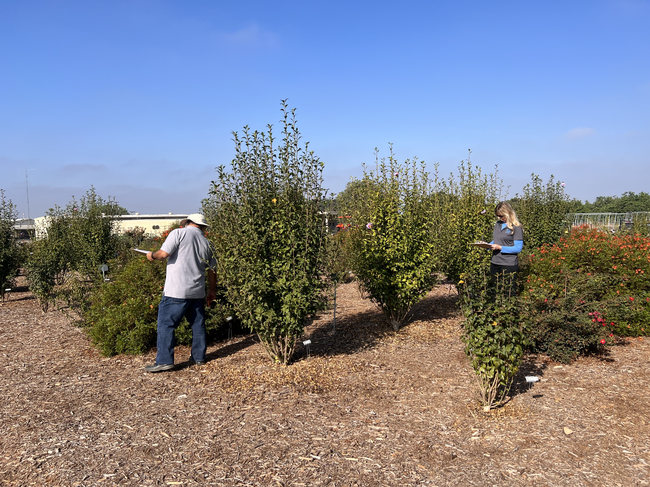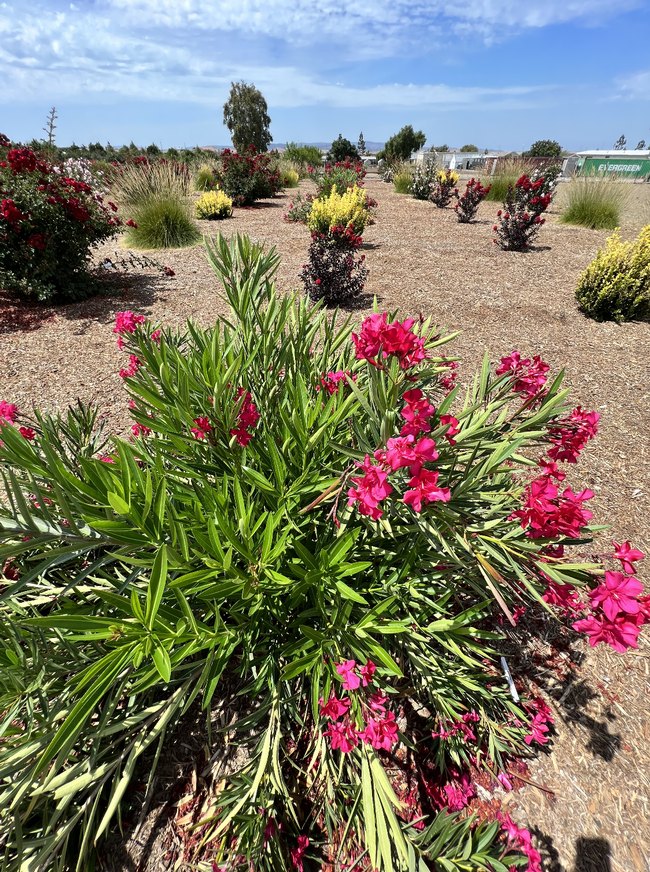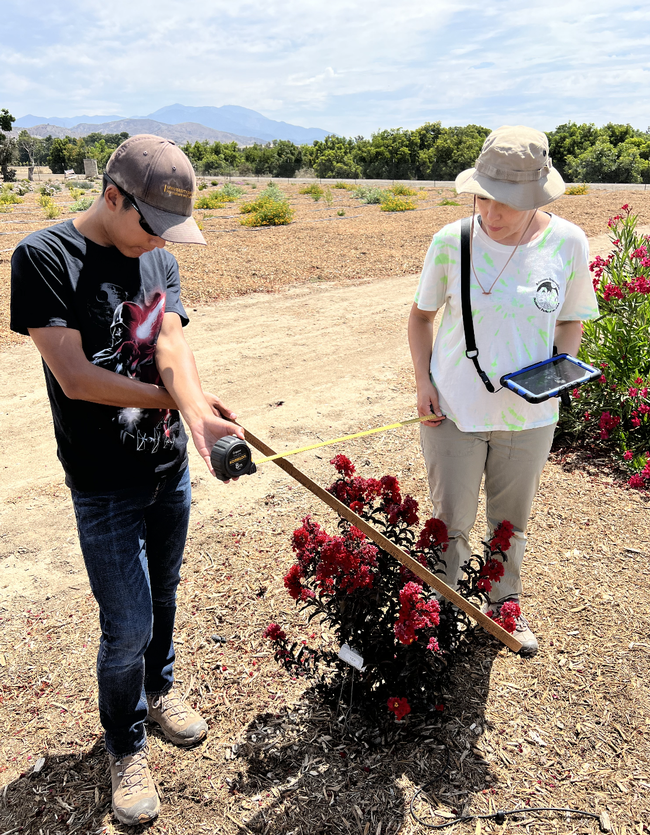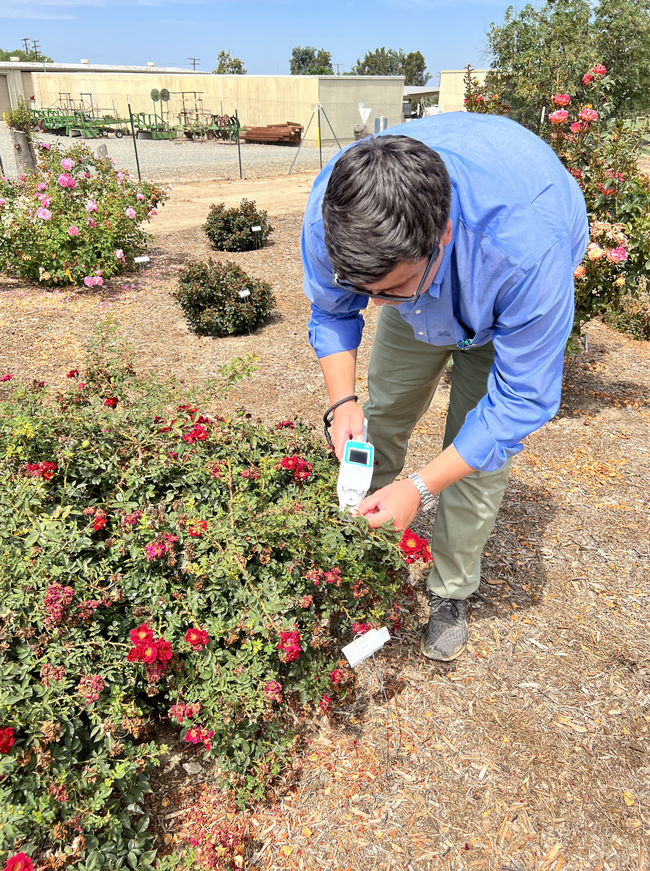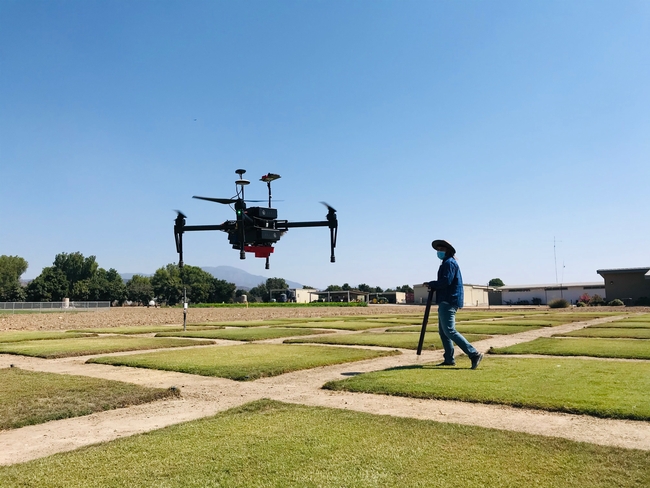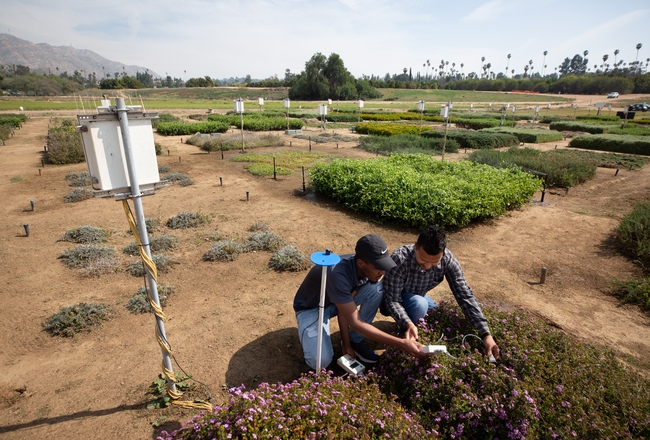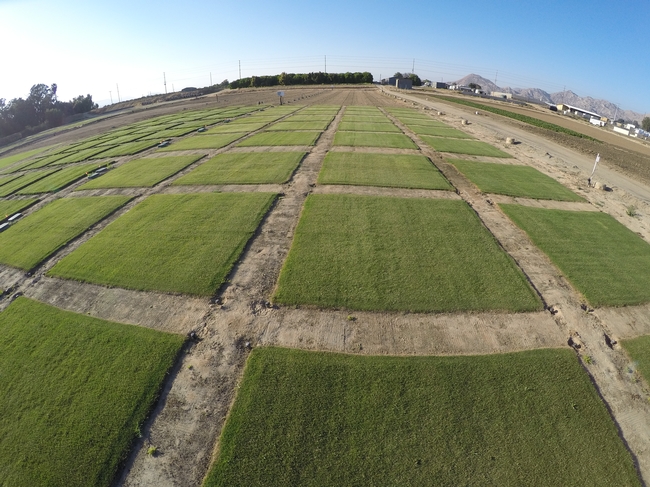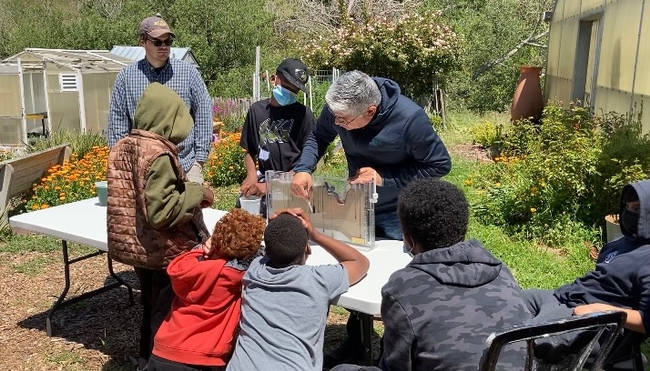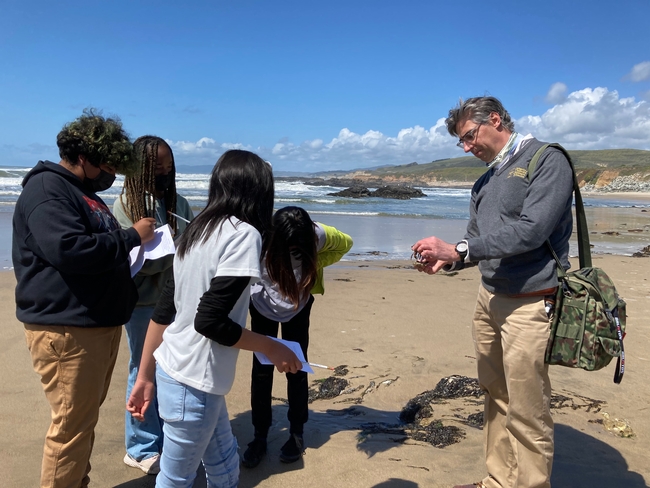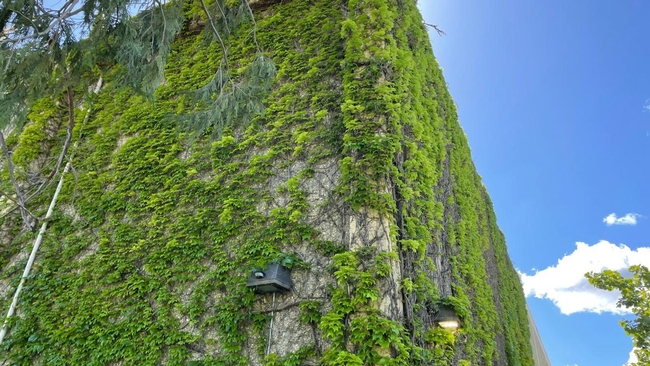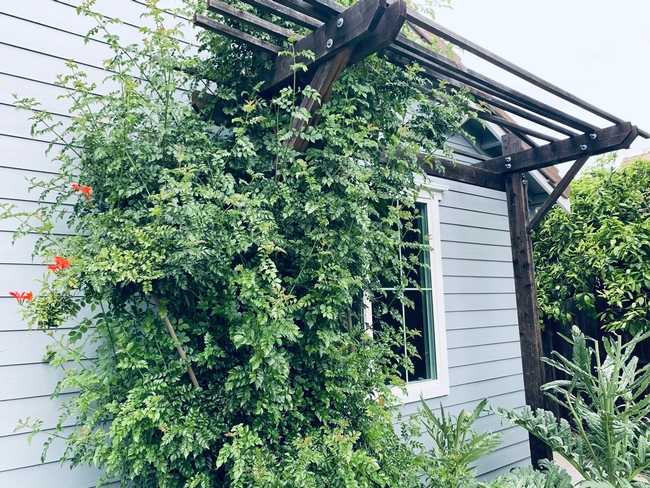Posts Tagged: Water
Your water-efficient landscape doesn’t have to be barren
UC climate-ready landscape trials identify low-water yet attractive plants
Good news: roses can be a part of your water-efficient landscape. Lorence Oki, UC Cooperative Extension environmental horticulture specialist in the UC Davis Department of Plant Sciences, identified rose cultivars that remain aesthetically pleasing with little water.
Oki is the principal investigator of the Climate-Ready Landscape Plants project, which may be the largest irrigation trial in the western U.S., and the UC Plant Landscape Irrigation Trials (UCLPIT), the California component of that project. These projects evaluate landscape plants under varying irrigation levels to determine their optimal performance in regions requiring supplemental summer water.
“There are some assumptions that pretty plants use a lot of water, like roses,” Oki said. “Everyone thinks they need a lot of water, but we've found some that don't, and they still look great. A water-efficient landscape doesn't need to look like a Central Valley oak-grassland in the summer. It can look really attractive.”
In 2021, Oki's team at UC Davis identified Lomandra confertifolia ssp. pallida "Pom Pom" Shorty and Rosa "Sprogreatpink" Brick House® Pink as two of the best low-water plants in the trial.
“The useful tip or information that is shared at the end of each trial is the selection and designation of plants as Blue Ribbon winners. These are the plants that looked good with an overall rating of 4 or higher throughout and were on the low (20%) water treatment,” said Natalie Levy, associate specialist for water resources, who manages the project at the UC ANR South Coast Research and Extension Center.
How plants earn a blue ribbon
Each trial year, the selection of new plants is based on research recommendations and donated submissions from the nursery industry. The landscape plants are trialed in full sun or 50% shade cover.
Irrigation treatments are based on the rate of evaporation and plant transpiration (evapotranspiration) measured through a local California Irrigation Management Information System (CIMIS) weather station that provides a reference evapotranspiration (ETo) rate.
Three levels of irrigation are provided to the plants equal to 20%, 50%, and 80% of ETo. The volume of water applied is the same at each irrigation based on soil characteristics, but the interval between applications varies with weather and the treatment. Using this method, irrigations for the 20% treatment are less frequent than the 80% treatment.
“The 20% treatment during the 2022 trial was irrigated an average of once per month while the 80% treatment was irrigated weekly,” explained Levy.
During the deficit irrigation trial, monthly height and width measurements are taken to determine the plant growth index. Monthly qualitative aesthetic ratings on a scale of 1 to 5 are determined for foliage appearance, flowering abundance, pest tolerance, disease resistance, vigor and overall appearance.
A second round of flowering abundance and overall appearance measurements are also taken to capture more of the blooming period. For example, UCLPIT identified in the 2020 trial at South Coast REC that the "Apricot Drift" rose had a mean overall appearance score of 3.5 out of 5, deeming it “acceptable to very nice” and a low water use plant within the Water Use Classification of Landscape Species or WUCOLS guide.
Project expands options for landscape planting
“(WUCOLS) only has 3,500 plants in it. There are guesses that there are close to 10,000 cultivars in urban landscapes in California, if not more,” said Oki. “WUCOLS also didn't have numerical ratings. Instead, you'll see verbal ratings like ‘low water use' or ‘high water use.'”
The UCLPIT project has not only developed numerical recommendations for irrigation, but it has also added new landscape plants that are compliant with California's Model Water Efficient Landscape Ordinance. In fact, UCLPIT's data is one of the few sources that can be used to supplement WUCOLS.
Geographic diversity of trial sites adds to knowledge base
In addition to UC Davis and South Coast REC in Irvine, the trials have expanded beyond California as the Climate-Ready Landscape Plants project and is in progress at Oregon State University, University of Washington, University of Arizona and Utah State University thanks to a USDA/CDFA grant awarded in 2020.
Lloyd Nackley, associate professor of nursery production and greenhouse management at Oregon State University, is the principal investigator of the trial in the Portland metro area, which is entering its third year.
“People know that there are drought tolerant plants, but there are many. We're trying to highlight lesser known or newer varieties. And even though the trial is three years, most gardeners would hope that their garden lasts longer than that,” said Nackley.
One of the observations that Nackley recalls is of the Hibiscus Purple Pillar plant. Unlike the trial at South Coast, the Purple Pillar did not perform well in Oregon in the spring.
“It wasn't until August that we saw the plant bloom and begin to look like what we saw from South Coast in April,” Nackley said.
Ursula Schuch, horticulture professor and principal investigator of the trial taking place at the University of Arizona, was also surprised at the range of performance among different plant types and the effects of irrigation, heat and temperature.
“This research will reassure green industry professionals that they can stretch their water budget to successfully cultivate more plants, watering them according to their needs instead of irrigating every plant according to the highest water-using plants,” said Schuch.
Although research is only conducted in the West, the hope is that there will be trials in other regions of U.S.
Doing so would yield comprehensive information about the plants and their performance in different climates. As extreme weather events persist in the U.S., disease pressure and risks do too. Trials throughout the country would provide location-specific data regarding disease susceptibility.
To learn more about the UCLPIT research project, visit https://ucanr.edu/sites/UCLPIT/
UCCE water management expert helps save water, increase supply in SoCal
Earlier this year, officials in Southern California declared a water shortage emergency resulting in restrictions such as limiting outdoor water use to one day of the week. While mandatory restrictions vary across the region, Amir Haghverdi, UC Cooperative Extension specialist and associate professor of agricultural and urban water management at UC Riverside, is using research to pinpoint irrigation strategies that will help communities reduce their demand for water and increase supply.
Haghverdi and his team are responding to a hotter and drier California by working to identify changes that can make a substantial difference in water savings.
While behavioral changes such as preventing leaks and turning the faucet off while brushing teeth can help, Haghverdi's research focuses on methodical changes like stressing green spaces, planting drought-tolerant plant species, using non-traditional water sources, and investing in technology to better control water use.
Testing a lawn's limits
For six years, Haghverdi and his team have performed stress tests on turfgrass to identify the lowest percent of evapotranspiration rate (ETo) that it can withstand and still survive. To do this, Haghverdi's team applies different percentages of ETo, obtained from weather stations, and monitors the performance of each landscape species over time.
While both cool-season and warm-season species can be stressed and still maintain their aesthetic value for a few weeks to several months, Haghverdi's results showed that warm-season turfgrass species require less water and can withstand water stress better.
The actual duration that people can apply less water depends on the type of turfgrass, the weather conditions and the stress level. For example, results showed that hybrid bermudagrass (a warm-season turfgrass) during summer in inland Southern California could keep its aesthetic value above the minimum threshold for 30 to 50 days, depending on the weather conditions, with irrigation application as low as 40% ETo.
In contrast, tall fescue, a cool-season turfgrass, even with 20% more water, showed signs of stress after only a few weeks and could not maintain its minimum acceptable quality.
Plant drought-tolerant species
Haghverdi's work demonstrates that when water conservation is the goal, alternative groundcover species are clearly superior to all turfgrass species and cultivars that they have tested so far. In fact, his team has identified drought-tolerant species that can maintain their aesthetic values with a third to a quarter less water than cool-season turfgrass (as low as 20% ETo) and can even withstand no-irrigation periods.
Furthermore, extensive field trials showed that new plant species from different regions could be as resilient as native species in withstanding drought and heat stress while maintaining their aesthetic beauty and cool canopy. Occasionally, they have outperformed native species, underscoring the advantages of drought- and heat-tolerant species that are non-native.
Based on Haghverdi's preliminary results for minimum irrigation requirement in inland Southern California, creeping Australian saltbush, a non-native species originally from Australia, and coyote bush, native to California, were top performers. Considering cooling benefits, drought tolerance and sensitivity to over-irrigation, creeping Australian saltbush performed the best.
Counties are already using recycled water
Although he recommends renewing your landscape with drought-tolerant or low-water use greenery and identifying how long your green spaces can live without water, Haghverdi acknowledges that, while contradictory, the cooling benefits of landscape irrigation are essential in Southern California.
“This is one of the tradeoffs of water conservation,” said Haghverdi. “If the only goal is to conserve water, maybe people will conclude that we don't have enough water to irrigate landscape.”
Water conservation efforts could influence counties to stop or reduce landscape irrigation. The consequences, however, would result in hotter environments due to the heat island effect. The loss of landscapes means that the sun's energy will be absorbed into the ground, instead of prompting transpiration in plants, which helps keep environments cool.
Thus, stressing green spaces and investing in drought-tolerant plant species help reduce the demand for water, but increasing water supply is just as vital. Haghverdi urges Southern California counties to prioritize a supplemental water supply such as recycled water – an approach already implemented in Ventura, Orange and San Diego counties.
The Metropolitan Water District of Southern California's Pure Water Southern California Program, formerly known as the Regional Recycled Water Program, aims to do just that. In partnership with the Los Angeles County Sanitation Districts, the program will further purify wastewater to produce a sustainable source of high-quality water for the region.
According to the program's website, this would “produce up to 150 million gallons of water daily when completed and provide purified water for up to 15 million people, making it one of the largest water reuse programs in the world.”
Smart controllers save time, money and water
Making the best use of the water you already have relies on efficiency. Sprinklers that are poorly placed, for example, are not as effective as they could be.
“What I see often while walking my dog in the neighborhood is that there's a lot of runoff, bad irrigation and bad timing like when it's windy,” Haghverdi observed. “People usually set their irrigation timer and then forget it, but they don't adjust it based on the season or weather parameters. That's not going to help us conserve water, a precious resource, in California.”
Thankfully, Haghverdi and his team have done extensive research on smart irrigation controllers, which, simply put, are irrigation timers with a sensor built in. Generally, there are two types of smart irrigation controllers: weather- and soil-based controllers.
Weather-based controllers use evapotranspiration data to automatically adjust their watering schedule according to local weather conditions. Soil-based controllers measure moisture at the root zone and start irrigating whenever the reading falls below a programmed threshold.
Smart controllers that have flowmeters can detect leaks and be activated automatically, whereas rain sensors can stop irrigation during rainfall. Although both additions are ideal for large irrigation landscapes such as parks and publicly maintained green spaces, rain sensors are easy to install and effective for residential areas too.
When asked about cost being a hindrance, Haghverdi responded, “Not a lot of people know that there are grants for smart controllers – some that will pay either all or a majority of the cost.”
To check if grants are available in your area, interested individuals are encouraged to contact their local water provider.
“We need to move towards autonomous and smart irrigation [strategies], and water management in urban areas. That's the future. If we can build autonomous cars, why can't we build smart water management systems that apply the right amount of water to each plant species, can detect leaks and prevent water waste?” said Haghverdi.
To learn more about or stay updated on Haghverdi's research, visit www.ucrwater.com.
Elementary school students explore water’s role in life
“I found so many things; I found a hermit crab, a starfish, a sea anemone,” exclaimed a Cherryland Elementary School student, his voice trailing off as he ventured back to the tide pools to explore more. The fifth grader from Hayward was participating in a 4-H Water Wizards course during a UC Cooperative Extension-sponsored field trip to Pescadero State Beach in San Mateo County.
In May, University of California Cooperative Extension bused 120 fifth and sixth graders from Hayward's Cherryland Elementary School – where the student population is 86% Hispanic and 6% Black – to UC Elkus Ranch Environmental Education Center in Half Moon Bay to learn about different aspects of water.
“These Black and Brown grade-school children are learning about water from people who look like them and speak like them,” said Frank McPherson, director of UC Cooperative Extension in the Bay Area, who is leading the launch of 4-H Water Wizards in the Bay Area. “As the students visit each experiential learning station and the ocean, the instructors are asking them thought-provoking questions like ‘How do you think the water will move through the landscape?' and ‘What do you see in the water?'”
4-H Water Wizards is designed to give socially disadvantaged students of color opportunities to meet diverse scientists and imagine career possibilities in science, technology, education and math, or STEM.
“I'm really happy that we were invited by the UC Agriculture and Natural Resources to come out to Elkus Ranch so my kids can participate in an opportunity to engage in not only the fun that's out here, but also the animals,” said JoDana Campbell, Ed.D., Cherryland Elementary fifth grade teacher. “I was also really impressed with the number of scientists that are actually here on this ranch that were able to work with my kids at the varying stations about this idea of water and how we utilize water. Not only in California, but just generally in the world: how does water work?”
This spring UC Cooperative Extension educator Tanya Henderson, in collaboration with Cherryland Elementary School teachers and Nancy Wright, Hayward Unified School District elementary science partner teacher, introduced four classes at Cherryland Elementary to the 11-week 4-H Water Wizards curriculum. One of the classes has had a series of substitute teachers all year, making Henderson the most consistent instructor for a few weeks.
One teacher wrote to McPherson expressing her appreciation for the teaching assistance, saying, “I am especially grateful for Ms. Tanya, our teacher. Having another adult to co-teach is invaluable to say the least. Her teaching methods and care to engage students is remarkable.”
The field trip to Elkus Ranch and the ocean expanded on the classroom water lessons.
At the first of four learning stations, UC Davis graduate students used an Enviroscape model to show the Cherryland students how rainwater runoff moves through a community. The youngsters placed plastic houses on the landscape and fashioned clay into walls and dams to protect their houses from flood waters. After observing simulated rain on their community, the students discussed the results.
“The dam made it worse!” said one student.
“Maybe we should remove the dam,” said Cassie Bonfil, a UC Davis graduate student. “The water naturally wants to flow to the river. We're blocking it from going to the river, forcing it to go up into the houses.”
Using sand between sheets of plexiglass as a window into a cross section of soil and an aquifer, UC Cooperative Extension specialist Samuel Sandoval Solis led the students in demonstrating the movement of water when it filters through soil into the ground and when water is pumped from wells.
In the Elkus Ranch children's garden, Henderson encouraged students to touch and smell plants that could be used to make soaps, salves and other products.
The students also interacted with the sheep, goats, rabbits, chickens and other livestock that live at Elkus Ranch. Beth Loof, 4-H youth community educator, discussed the role of animals in agriculture as well as their relationships to soil, water and food systems.
“I just think it's a really good opportunity to engage inner city youth in something where they do not have an opportunity to engage in normally,” said Campbell, the Cherryland teacher. “This ranch is an awesome opportunity to come out to learn, there's a great museum up the way. My kids have been very excited about the whole process.”
The curriculum and educator are funded by a grant from USDA National Institute or Food and Agriculture, but to hire more buses to transport more schoolchildren to Elkus Ranch for the outdoor experience, McPherson is raising money. Donations to the Bay Area 4-H Water Wizards project can be made at https://donate.ucanr.edu/?program=California 4-H&county=Alameda.
Water measurement and reporting courses offered by UCCE May 26
California water-rights holders are required by state law to measure and report the water they divert from surface streams. For people who wish to take the water measurements themselves, the University of California Cooperative Extension is offering a virtual training to receive certification on May 26.
At the workshop, participants can expect to
- clarify reporting requirements for ranches.
- understand what meters are appropriate for different situations.
- learn how to determine measurement equipment accuracy.
- develop an understanding of measurement weirs.
- learn how to calculate and report volume from flow data.
“We are limiting the number participants for the water measurement training to 30 people per session,” said Larry Forero, UC Cooperative Extension livestock and natural resources advisor. “If you need this training, please register soon.”
The scheduled trainings will be held Thursday, May 26, at two locations:
- Redding at Shasta College Farm. Registration is required and costs $25. To register visit https://ceshasta.ucanr.edu. For more information, contact Larry Forero (lcforero@ucanr.edu) or Sara Jaimes (sbjaimes@ucanr.edu) or by calling the UCCE office in Shasta County at (530) 224-4900. Training will begin at 8 a.m. and conclude at 11:30 am.
- Woodland at the UC Cooperative Extension at 70 Cottonwood Street. Registration costs $20. To register, visit https://cecapitolcorridor.ucanr.edu. For more information, contact Morgan Doran at mpdoran@ucanr.edu or the UCCE Yolo County office at (530) 666-8143. Training will begin at 2:30 p.m. and conclude at 5:30 pm.
Background:
Senate Bill 88 requires all water right holders who have previously diverted or intend to divert more than 10 acre-feet per year (riparian and pre-1914 claims), or who are authorized to divert more than 10 acre-feet per year under a permit, license or registration, to measure and report the water they divert. Detailed information on the regulatory requirements for measurement and reporting is available on the State Water Resources Control Board Reporting and Measurement Regulation webpage. The legislation requires that installation and certification of measurement methods for diversion (or storage) greater than or equal to 100-acre feet annually be approved by an engineer/contractor/professional.
California Cattlemen's Association worked with Assemblyman Frank Bigelow on a bill that allows a self-certification option. Assembly Bill 589 became law on Jan. 1, 2018. This bill, until Jan. 1, 2023, allows any diverter who has completed this instructional course on measurement devices and methods administered by the University of California Cooperative Extension, and passes a proficiency test, to be considered a qualified individual when installing and maintaining devices or implementing methods of measurement.
Can vines speed urban cooling?
Study explores cooling benefits of fast-growing vines as trees take their time
Perhaps trees aren't the only green solution when it comes to cooling urban spaces and reducing energy costs. Honeysuckle, Virginia creeper, pink trumpet and other vines could be a fast-growing substitute in climate-smart cities of the future.
Researchers from UC Davis are leading a nearly $880,000 federal grant to study how vines may provide cooling and shade in Western states in less time than it takes a tree to grow tall.
“Vines can quickly shade buildings and reduce energy consumption while trees slowly grow to maturity,” said Alessandro Ossola, an assistant professor of plant sciences who is a principal investigator for the project. “We believe vines can be an effective and cheap measure to help cities accelerating climate change adaptation.”
The grant from the U.S. Department of Agriculture's Agricultural Marketing Service will fund work to plant and monitor at least 10 types of vines on trellises in five locations in different climate zones over three years. California Department of Food and Agriculture is administering the grant.
Using less water
Water conservation will be vital as populations rise, climate extremes become more prevalent and the demand for agricultural and drinking water increases. The goal of this research is to identify vines that can help save energy by providing cooling and reduce the need for irrigated water.
“In addition to rapid growth rates, vines can be easily integrated with structures to maximize potential cooling effects,” said Loren Oki, a Cooperative Extension specialist with Department of Plant Sciences, who is the project lead. “But we need to understand the relationships between low water-use plants and their ability to reduce thermal loads on buildings.”
The vines will be planted, supported by a trellis and watered regularly during the first growing season to establish deep roots and healthy shoots. Over the next two years, the vines will experience low, moderate and high water allocations.
The vines will be rated on aesthetics, foliage quality, floral quantity, pest and disease resistance, appearance and other factors. Thermal images of trellis coverage and other environmental measurements will also be taken to assess shading and cooling potential, according to grant documents.
Many vines can be grown along cables and wire nets that are actually detached from walls to avoid direct contact and still provide shade, Ossola said.
“We want to understand which vine characteristics relate to fast growth, reduced water use and increased aesthetic appeal,” he added.
Outreach and education
The findings will enable recommendations to be developed for regions, planners, the landscape industry and the public. It could lead to plants being designated as “water-wise,” “low-water use,” “energy-saving” or “cooling.”
Extensive engagement and outreach will also publicize the information.
“Climate change is a great opportunity for the horticultural industry to innovate and promote climate-ready plant productions,” Ossola said.
USDA funding supports research across state lines to find innovative solutions to regional and national problems, USDA Under Secretary for Marketing and Regulatory Programs Jenny Lester Moffitt said in a news release announcing this and other grants.
“This year's funded projects will address a range of those challenges, from energy and water saving in vine plants, finding cost-effective solutions for heat tolerance and drought, to addressing food safety risks for produce,” Moffitt said.
Scientists from the University of Arizona, University of Washington, Utah State University and the South Coast Research and Extension Center at UC Agricultural and Natural Resources are contributing to the research and will be overseeing vine sites in their states.
This article is reprinted from the UC Davis College of Agricultural and Environmental (CA&ES) website, where it is titled "Could Vines Be the Answers to Speeding Urban Cooling, Water Reduction in the West?"


